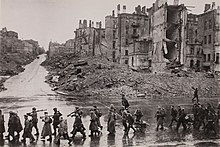This article needs additional citations for verification. (March 2013) |
| Second Battle of Kiev | |||||||||
|---|---|---|---|---|---|---|---|---|---|
| Part of the Eastern Front of World War II | |||||||||
 Kiev after its liberation in November 1943. | |||||||||
| |||||||||
| Belligerents | |||||||||
|
|
| ||||||||
| Commanders and leaders | |||||||||
|
|
| ||||||||
| Units involved | |||||||||
| 1st Ukrainian Front | 4th Panzer Army | ||||||||
| Strength | |||||||||
|
730,000 men[2] 7,000 guns and mortars 675 tanks and assault guns 700 combat aircraft |
On 1 November 1943:[3] - 276,978 men in total | ||||||||
| Casualties and losses | |||||||||
|
118,042 men[2]
125 aircraft (3–13 November) |
16,992 men[4]
| ||||||||
The Second Battle of Kiev was a part of a much wider Soviet offensive in Ukraine known as the Battle of the Dnieper involving three strategic operations by the Soviet Red Army and its Czechoslovak units[1] and one operational counterattack by the Wehrmacht, which took place between 3 November and 22 December 1943.
Following the Battle of Kursk, the Red Army launched the Belgorod-Kharkov Offensive Operation, pushing Erich von Manstein's Army Group South back towards the Dnieper River. Stavka, the Soviet high command, ordered the Central Front and the Voronezh Front to force crossings of the Dnieper. When this was unsuccessful in October, the effort was handed over to the 1st Ukrainian Front, with some support from the 2nd Ukrainian Front. The 1st Ukrainian Front, commanded by Nikolai Vatutin, was able to secure bridgeheads north and south of Kiev.
- ^ a b Cite error: The named reference
czwas invoked but never defined (see the help page). - ^ a b Frieser et al. 2007, pp. 366–370.
- ^ Pz. AOK 4 Oberquartiermeister Nr. 1834/43 g. Kdos. Verpflegungsstärken nach dem Stande vom 1.11.43. NARA T313, R390, F8680072.
- ^ "1943". Archived from the original on 25 May 2013. Retrieved 10 December 2017.